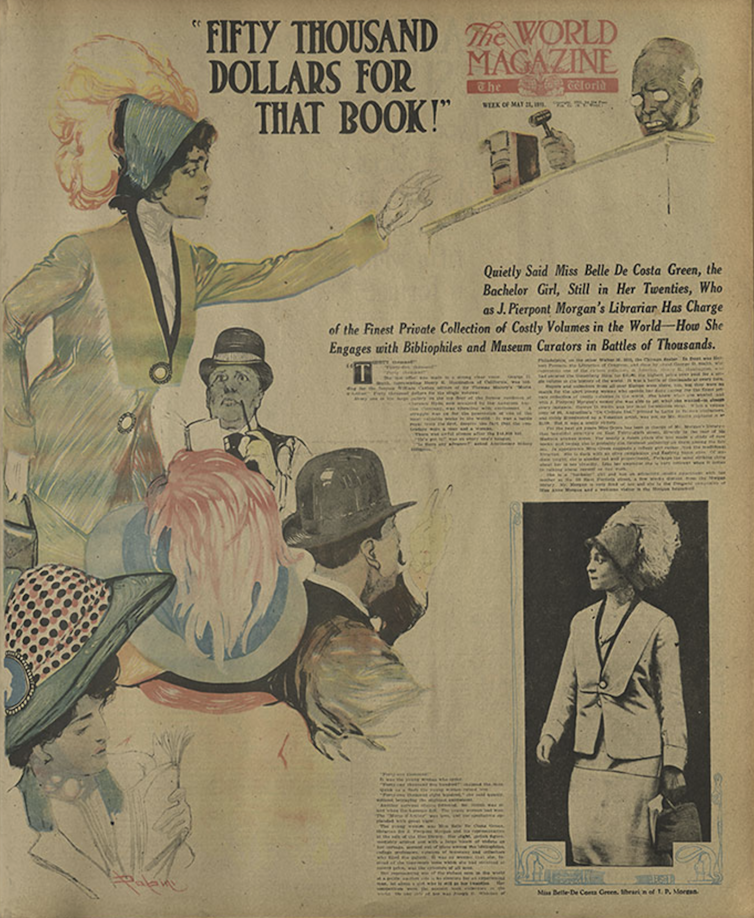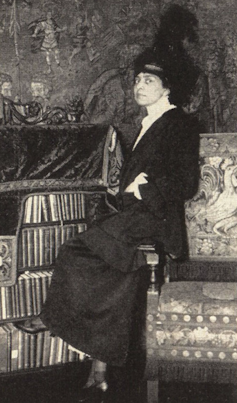“Just Because I am a Librarian doesn’t mean I have to dress like one.”
With this breezy pronouncement, Belle da Costa Greene handily differentiated herself from most librarians.
She stood out for other reasons, too.
In the early 20th century – a time when men held most positions of authority – Greene was a celebrated book agent, a curator and the first director of the Morgan Library. She also earned US$10,000 a year, about $280,000 today, while other librarians were making roughly $400.
She was also a Black woman who passed as white.
Born in 1879, Belle was the daughter of two light-skinned Black Americans, Genevieve Fleet and Richard T. Greener, the first Black man to graduate from Harvard. When the two separated in 1897, Fleet changed the family’s last name to Greene and, along with her five children, crossed the color line. Belle Marion Greener became Belle da Costa Greene – the “da Costa” a subtle claim to her Portuguese ancestry.
Biblioteca Berenson, I Tatti, the Harvard University Center for Italian Renaissance Studies
When banking magnate J.P. Morgan sought a librarian in 1905, his nephew Junius Morgan recommended Greene, who had been one of his co-workers at the Princeton Library.
Henceforth, Greene’s life didn’t just kick into a higher gear. It was supercharged. She became a lively fixture at social gatherings among America’s wealthiest families. Her world encompassed Gilded Age mansions, country retreats, rare book enclaves, auction houses, museums and art galleries. Bold, vivacious and glamorous, the keenly intelligent Greene attracted attention wherever she went.
I found myself drawn to the worlds Greene entered and the people she described in her lively letters to her lover, art scholar Bernard Berenson. In 2024, I published a book, “Becoming Belle Da Costa Greene,” which explores her voice, her self-invention, her love of art and literature, and her path-breaking work as a librarian.
Yet I’m often asked whether Greene mentions her passing as white in her writings. She did not. Greene was one of hundreds of thousands of light-skinned Black Americans who passed as white in the Jim Crow era. While speculation about Greene’s background circulated in her lifetime, nothing was confirmed until historian Jean Strouse revealed the identities of Greene’s parents in her 1999 biography, “Morgan: American Financier.” Until that point, only Greene’s mother and siblings knew the story of their Black heritage.
“Passing” can often raise more questions than answers. But Greene did not largely define herself through one category, such as her racial identity. Instead, she constructed a self through the things she loved.
‘I love this life – don’t you?’
In my view, any consideration of Greene’s attitudes toward her own race must remain an open question. And uncertainty can be acknowledged – even embraced – with judgments suspended.
The Morgan Library & Museum currently has an exhibition on Greene that will run until May 4, 2025 – one that’s already generated debates about Greene and the significance of her passing.
One section of the exhibition, “Questioning the Color Line,” includes novels on passing, paintings such as Archibald J. Motley Jr.’s “The Octoroon Girl,” photographs of Greene, and clips from Oscar Micheaux’s 1932 film “Veiled Aristocrats” and John M. Stahl’s 1934 film “Imitation of Life,” which portray painful scenes between white-passing characters and their family members.
None of these objects clarifies Greene’s particular relationship to passing. Instead, they place the librarian within melodramatic and conventional representations about passing that stress self-division and angst.
We don’t know – perhaps we will never know – whether Greene had similar moments of self-doubt.

The Morgan Library & Museum
Yet some critics have concluded as much. In his review of the exhibition for The New Yorker, critic Hilton Als laments what Greene’s passing had cost her. He describes her as a “girl who loved power,” a woman who “became a member of another race – not Black or white but alternately grandiose and self-despising.”
There’s a lot of certainty in such a pronouncement – and scant evidence furnished to support such declarations.
New York Times columnist John McWhorter takes issue with Als’s depiction of the librarian’s passing in a Jan. 23, 2025, article.
Citing passages from her letters in which Greene excitedly describes reading the Arabic folktales “The Thousand and One Nights” and seeing exhibitions of modern art, McWhorter asks readers to reconsider this “witty, puckish soul who savored books and art” and “had an active social life.”
What if Greene gave her race little thought, McWhorter wonders. What if she simply saw the notion of race and racial categorization as “a fiction” and instead lived her life to its fullest? Of course, her light skin afforded her the opportunity that other Black people of her era didn’t have. But does that necessarily mean that she was self-loathing or conflicted?
“[W]e are all wearing trousers and I love them,” Greene writes in one letter to Berenson, adding, “The Library grows more wonderful every day and I am terribly happy in my work here … I love this life – don’t you?”
Greene’s vitality captivated Berenson, who once described the librarian as “incredibly and miraculously responsive.”
The connoisseur was not the only contemporary who admired Greene’s effervescence. In “The Living Present,” an account of the activities of women before and after World War II, Greene’s friend Gertrude Atherton paid tribute to Greene, a “girl so fond of society, so fashionable in dress and appointments” that she could impress any stranger with her “overflowing joie de vivre.”
Crafting an aura
Viewed through a more expansive lens, Greene’s passing can be seen as part of an exercise in self-fashioning and self-invention.
Greene dressed to be noticed – and she was. Meta Harrsen, the librarian Greene hired in 1922, offers a rare eye-witness account. On the day Greene interviewed Harrsen, “she wore a dress of dark red Italian brocade shot with silver threads, a gold braided girdle, and an emerald necklace.”
Greene understood well the power of clothes to project a distinct identity – a highly crafted one in this case, and one befitting a connoisseur of rare books.

The Morgan Library & Museum
At that, she excelled. She became known for her stunning acquisition coups: her purchase of 16 rare editions of the works of English printer William Caxton at an auction; her procurement of the highly coveted Crusader’s Bible through a private negotiation; and her acquisition of the Spanish Apocalypse Commentary, a medieval text written by a Spanish monk that Greene was able to buy at a steep discount.
To me, a 1915 photo captures Greene’s confidence and aura more than any other image of the librarian.
She posed in her home and wasn’t shot in soft focus with a studio backdrop as other photographs tend to portray her. Sitting on the arm of a large chair upholstered in a tapestry weave, she wears an elaborate hat with a large ostrich plume, a high-necked blouse under a long, loosely belted jacket with a ruffled cuff over a long dark skirt. The decor is no less striking: Flemish tapestries decorate the walls behind her, and a liturgical vestment is draped over the bookcase. Looking directly at the viewer, Greene is assured and poised.
Greene’s stylish flair was not simply decorative. It was a testament to her vibrant personality and the joy she took in her work. Rather than judge her according to contemporary notions of racial identity, I prefer to marvel over her achievements and how she became a model for generations of future librarians.
Greene didn’t just pass. She surpassed – in spectacular ways.
